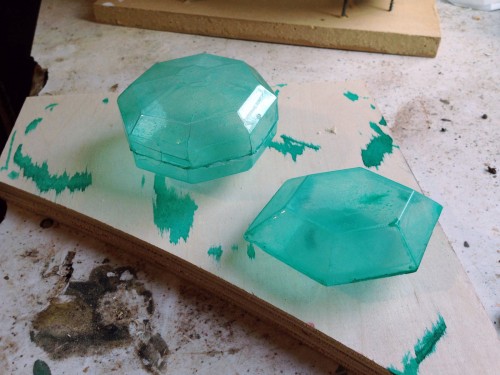For the last few weeks before I came out to Santa Fe, I was building some props for a local theatre group known as The League of Extraordinary Thespians. They are doing a musical of The Legend of Zelda: Ocarina of Time. The first props I finished were the rupees, which are a type of jewel used in the game to buy items (some of you may have already seen these in an Instructable I posted last week. Sorry).
I figured the best way to make a translucent gem was to vacuum form the shape. You remember my ultra-cheap vacuum former, correct? Before I could use that, I would need a form. I decided to do the front and back of each rupee separately, and then glue them together. So first, I would need to cut a piece of wood into a rupee shape.

You can see I’m using the (oddly-named) GRR-Ripper from Micro-Jig; it makes accurate cuts on tiny pieces in a safe and straight-forward manner. I did all the cuts with my table saw, giving me a pretty clean-looking rupee half.

I got a sheet of clear acrylic from Hobby Lobby. They only had it in one thickness; I’m not sure what it is exactly, but it’s less than 1/16″. I started vacuum forming the halves and trimming them out, leaving exactly what you see above.

Before gluing the halves together, I painted the insides. This way, the paint would never wear off, no matter how much the actors handled them.
For the green ones, I tried watering down acrylic paint. It was pretty tricky, since the paint kept wanting to bead up. Normally, you would lightly sand the surface of the plastic to help the paint adhere better, but that would kind of kill the “translucency” effect. So I bit the bullet and bought some blue and red spray paint so I could just lightly dust the other rupees.

I used a solvent-based glue (Amazing Goop) to glue the halves together. The glue was a bit thick and dried flexible, which helped make a stronger bond since the edges didn’t quite match up exactly.
And that is how you make a rupee!




